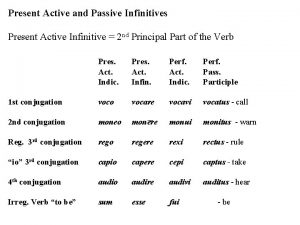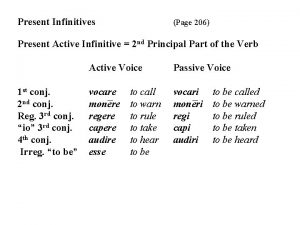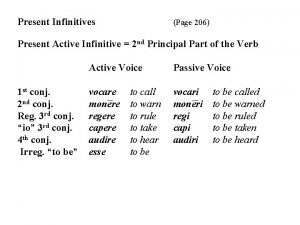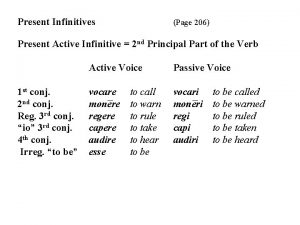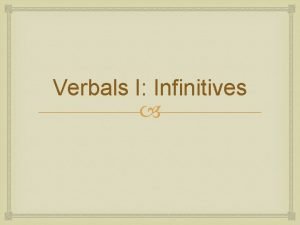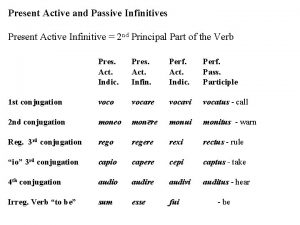Present Infinitives Page 206 Present Active Infinitive 2







- Slides: 7

Present Infinitives (Page 206) Present Active Infinitive = 2 nd Principal Part of the Verb 1 st conj. 2 nd conj. Reg. 3 rd conj. “io” 3 rd conj. 4 th conj. Irreg. “to be” Active Voice Passive Voice vocare monere regere capere audire esse vocari moneri regi capi audiri to call to warn to rule to take to hear to be called to be warned to be ruled to be taken to be heard

Perfect Active Infinitive (Page 271) In English to have is the indicator of the perfect active infinitive, which is formed by combining to have with the perfect participle: to have + called = to have called. In Latin the perfect active infinitive is formed by adding the indicator -isse to the perfect stem: vocav + isse = vocavisse = to have called First Second Third -io Fourth Perf. Stem + vocav monu rex cep audiv + + + Infinitive Ending isse isse = Form = = = vocavisse monuisse rexisse cepisse audivisse to have called to have warned to have ruled to have taken to have heard

Perfect Passive Infinitive (Page 272) In English to have been is the indicator of the perfect passive infinitive, which is formed by combining to have been with the perfect participle: to have been + called = to have been called. In Latin the perfect passive infinitive is formed by combining the perfect passive participle with esse: vocatus + esse = vocatus esse = to have been called First Second Third -io Fourth Perf. Pass. Part. + esse = Form vocatus -a -um monitus -a -um rectus -a -um captus -a -um auditus -a -um esse esse = = = + + + vocatus -a -um esse = to have been called monitus -a -um esse = to have been warned rectus -a -um esse = to have been ruled captus -a -um esse = to have been taken auditus -a -um esse = to have been heard

Future Active Infinitive (Page 277) In English there is no special form for the future active infinitive. In Latin the future active infinitive is a combination of the future active participle + esse. The future active participle is made up of the participial stem + ur + us -a -um: vocat + ur + us -a -um = vocaturus -a -um = about to call The indicator for the future participle is -urvocaturus + esse = vocaturus esse = to be about to call Fut. Act. Part. First vocaturus -a -um Second moniturus -a -um Third recturus -a -urn Third -io capturus -a -um Fourth auditurus -a -um + + + esse esse = = = Form vocaturus esse to be about to call moniturus esse to be about to warn recturus esse to be about to rule capturus esse to be about to take auditurus esse to be about to hear

The Four Uses of the Infinitive 1. Complementary Infinitive (English Word Order = Subject Verb Infinitive) The man desires to work. Vir laborare desiderat. 2. Subjective Infinitive (Infinitive used as a subject or predicate nominative) It is pleasant to walk. Ambulare est gratum. or Est gratum ambulare. 3. Objective Infinitive (English Word Order = Subject Verb Noun/Pronoun Infinitive) The farmer taught the slaves to work. Agricola servos laborare docuit. (The accusative noun servos in front of the infinitive is called a subject accusative. )

The Four Uses of the Infinitive 4. Indirect Statement (Indirect Discourse) 5. 6. 7. 8. In Latin when a simple statement is indirectly quoted, the verb is changed from the indicative mood in the direct statement to the infinitive in the indirect statement, and the subject is changed from the nominative to the accusative case. 9. Direct statement: 10. Indirect statement: that the man 11. Vir ambulat. (Page 278) The man is walking. Dicit virum ambulare. He says is walking. 12. Difference between English and Latin Indirect Statement 13. English Latin 14. The verb is finite. The verb is in the infinitive. 15. The introductory word that is used. There is no introductory word.

Nota Bene: (Page 278) Indirect Statements usually follow verbs of mental action, such as say, tell, know, think, hear, perceive, and the like. These verbs should be memorized: dico (3), say, tell scio (4), know puto (1), think audio (4), hear nego (1), say not, deny video (2), see nuntio (1), announce, tell sentio (4), feel, perceive existimo (1), think Sequence of Tenses for Indirect Statement The present infinitive denotes the same time as the main verb; The perfect infinitive denotes time before that of the main verb; The future infinitive denotes time after that of the main verb.

